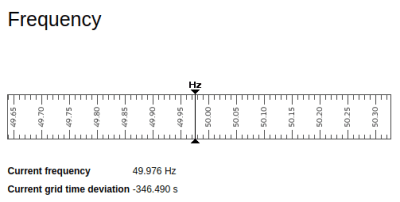You might be reading this six minutes early. Assuming that the Hackaday editors have done their job, this article should have appeared in your feed right on the half-hour. We have a set schedule to keep you supplied with the tastiest of hardware hacks and news. For some of you though perhaps there has been a treat, you’ve seen it and all the other stories six minutes early.
Have you perfected time travel? Sadly not unless there’s something you’d like to send to our tips line last week, but the culprit is equally fascinating. A dispute between Serbia and Kosovo has caused the frequency of the interconnected continental European electricity grid to drift below its usual 50 Hz figure for a sustained period, and as a result all clocks that use the mains frequency as a time reference have been getting ever slower.
How Can a Continental Power Grid Dip?
Think for a minute of a modern car on a hot day. When you turn on the air conditioning you will hear a slight dip in the engine revs as it accommodates the extra load. So it is with an alternating current power grid; a simple example is a power station supplying a city. In periods such as cold nights when the demands of the city go up, the result would be that the power station needs to work harder to satisfy it, and until that happens there would be a slight dip in its line frequency. Power grids compensate for this by increasing and decreasing the available generating capacity in real time, maintaining a mean frequency such that the “grid time” of a clock controlled by it matches an atomic clock as closely as possible over time.

In the case of continental Europe, grids across multiple countries are connected (PDF), and the task of maintaining that mean frequency falls upon Swissgrid which currently shows a sagging 49.976 Hz frequency. The time deviation of -346 seconds puts this close to a six minute loss and clocks running on this frequency will make you late to your next appointment.
It is at this point we leave the realm of electrical engineering and enter that of international politics, normally something far removed from Hackaday’s remit. It is fair to say that the history between Serbia and Kosovo is extremely delicate, and to understand some of the context of this story you should read about the war at the end of the 1990s. After the conflict the Serbian-majority region of what is now Kosovo refused to pay the Kosovan utility for its electricity, eventually leading to the Kosovans refusing to pay for that region’s share of the power received by Kosovo from Serbia. The resulting imbalance between demand and supply was enough to drag the supply frequency down across the whole continent, and though a short-term agreement has been reached the problem still remains on the grid.
Clocks and Mains Frequency
So if you are a continental European and you find yourself six minutes behind your British or American friends, don’t worry. We know that among our readers are people with significant experience in the power generation world, perhaps some of you would like to use your six minutes to give us a bit of insight in the comments. Meanwhile here at Hackaday we maintain an interest in the mechanics of power distribution even if some might say that it is Not A Hack. We’ve taken a look at utility poles, and examined how power grids are synchronised.
As for those slow clocks, the use of mains frequency to keep accurate time is quite brilliant and has been used reliably for decades. Tightly regulating grid frequency means that any clock plugged into an outlet can have the same dead-on accuracy for the cost of a few diodes. These clocks count the zero crossing of the alternating current. There may be moment to moment drifts but the power utility injects or removes cycles over the long term so the sum of crossings is dead on over the course of the day. It’s an interesting phenomenon to experiment with and that’s why we see it in microcontroller projects from time to time.












